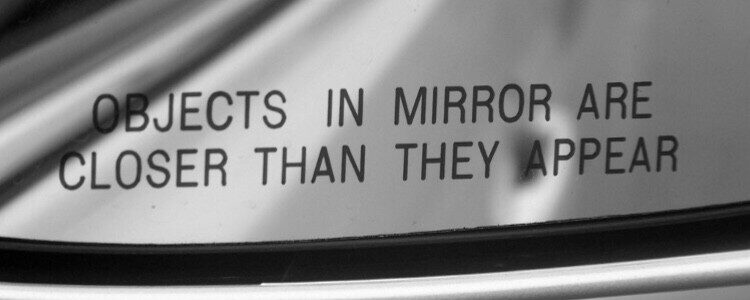Looking Backward to Go Forward: Part 2
December 2020
Dear Fellow Advent Traveler:
Last month I wrote about how our life in the Holy Christian Church might be compared to driving in traffic, merging from the on-ramp onto a highway. You have to look backward at what is behind you in order to step on the gas and move forward toward what lies ahead of you. This month I am expanding that thought with the little phrase that is engraved on all the outside rearview mirrors of our cars, “Objects in the Rearview Mirror are Closer Than They Appear.” Those side mirrors distort reality. Because they are convex in order to give a wide field of vision, they also make objects appear small. Smaller objects always seem like they are farther away from us, with the result that cars or trucks that appear as if they are blocks behind you are actually quite close to you. So the warning on the mirrors is necessary as a reminder that the objects you see in those mirrors are closer to your car than they actually appear.
What does all of this have to do with our life together in the Holy Christian Church? As I talked about last month in the Gloria Dei Messenger Pastoral Letter, I think that we in the 21st century Church will need to look backward into the Church’s History in order to go boldly and joyfully forward into our future. And, I think that, like the warning on our rear view mirrors, our history is much closer to us than we think, or than at first appears.
We have just celebrated in November our 80th Anniversary, looking backward to our founding and the hard work of those who came before us to establish and build up this congregation for the proclamation of the saving Gospel. Before that, in October, we celebrated the Reformation of the Church, looking backward to the hard work of the Reformers to restore the true and pure proclamation of that same saving Gospel. But these celebrations were both also looking forward, not just backward. These celebrations inform who we are today, because of what those who came before us did and confessed. The Church’s past is never too far away from us—it is always ‘closer than it appears.’
For example, think of the holy Season of Advent in which we find ourselves right now. Advent was already celebrated as a time of fasting and devotion leading up to Christmas by 480 A.D. It is probably much older than that, but its origins are clouded in the mist of the earliest days of the ancient Christian Church. So for at least 1,540 years, the Church has been celebrating the season of Advent. But that ancient history is as contemporary as right here and right now, what we are celebrating every Sunday.
So also with the celebration of Christmas: there are still those who cling to the foolish and disproven idea that the date and celebration of Christmas are somehow tied to paganism, or that they came from pagan origins that were then incorporated into early Christianity. This is, of course, ridiculous, and easily disprovable. The incarnation (which means ‘taking on human flesh’) and birth of Christ by the Blesséd Virgin Mary have been celebrated by the Church on either December 25 or January 6 since early day, and certainly since 200 A.D. There is ample evidence that point to December 25 as the birth of our Lord Jesus Christ. The idea that our celebrations of Christmas had their origins in paganism is also easily refuted. So, like Advent, Christmas is part of the ancient story that is as contemporary to us as right here and right now.
Let us rejoice together this year in a holy and joyful Advent and Christmas in Christ Jesus. Let us look backward to those who have gone before us in the holy Christian Church, and—guided by their faithfulness—move always boldly forward, knowing that what is behind us is much closer to us than we might think, helping to guide our steps. And let us prayerfully think of our life together in the Holy Christian Church, and what it might look like, especially here in our congregation. How might the Church’s history help to shape our future here together? How might we live together better in Christian community, loving and serving each other and our neighbors? What might it look like to live more and more in the Word of Christ and in His Holy Sacrament, so that these divine gifts that bring heaven down to earth might increasingly become the central things in our lives?
Please ponder these questions as you prepare your hearts to receive your Advent and Christmas King again this year. “O Come, O Come, Emmanuel, And ransom captive Israel, That mourns in lonely exile here Until the Son of God appear. Rejoice, rejoice! Emmanuel Shall come to thee, O Israel!”
Your servant in Christ,
Pastor Steven J. Anderson

